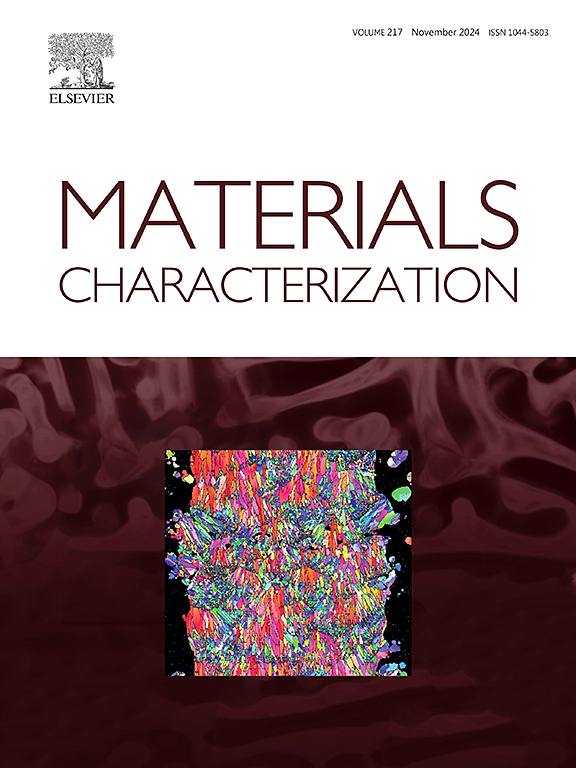ce改性Al-5Mg合金中不同的相演化和变形不稳定模式
IF 4.8
2区 材料科学
Q1 MATERIALS SCIENCE, CHARACTERIZATION & TESTING
引用次数: 0
摘要
本研究对比分析了Ce添加量(1wt %)对直接冷铸(DC) Al-5Mg的速率相关变形不稳定性模式的影响,该模式与相应的相和显微组织演变完全相关并得到了解释。显微镜结果显示,在较高温度下形成了大量富ce共晶金属间化合物(主要是Al11Ce3和Al13CeMg6类型),在凝固的最后阶段有效地抑制了β-Al3Mg2共晶相的形成,这一模式通过Scheil模拟进一步证实。电子背散射衍射(EBSD)分析表明,ce改性合金的晶粒尺寸演变更粗,更不均匀,这是由于潜在的CeTi反应以及熔体中使用的富钛晶粒细化剂的中和作用。此外,添加ce的合金在铸态表现出更强的织构发展,这主要是由于晶粒细化剂的有效性降低以及在凝固过程中随着α-Al初生相结晶而出现的富ce金属间化合物的钉住和稳定作用。在不同应变速率(10−4 ~ 10−2 s−1)下的拉伸变形分析揭示了不同的不稳定模式的发展,其特征是Portevin-Le Chatelier (PLC)带的演变。两种合金在不同应变速率下均出现了相似类型的条带,但ce改性合金表现出更高的应力降幅度和更低的条带形成频率,总体上表明了更局部的应变发展。同时,添加ce的合金在较低的应变速率为10−4 s−1时,表现出明显更高的临界应变εc(流动不稳定开始时的应变,8.15% vs 2.62%),从而实现了更长的均匀变形,从而提高了对流动稳定性和表面质量至关重要的钣金成形工艺的成形性潜力(例如,在汽车车身板的冲压应用中)。本文章由计算机程序翻译,如有差异,请以英文原文为准。
Distinct phase evolution and deformation instability pattern in a Ce-modified Al-5Mg alloy
This study presents a comparative analysis of the effects of Ce addition (1 wt%) on the rate-dependent deformation instability pattern of a Direct Chill (DC)-cast Al-5Mg, thoroughly linked to and explained by the corresponding phase and microstructural evolution. Microscopy results revealed the formation of a considerable volume of Ce-rich eutectic intermetallics (primarily of Al11Ce3 and Al13CeMg6 types) at higher temperatures, effectively suppressing the formation of the β-Al3Mg2 eutectic phase towards the final stages of solidification, a pattern further confirmed via Scheil simulations. Electron Backscatter Diffraction (EBSD) analysis revealed a coarser and less uniform grain size evolution in the Ce-modified alloy, attributed to the potential Ce![]() Ti reaction and, therefore, the neutralization of Ti-rich grain refiners used in the melt. Furthermore, the Ce-added alloy exhibited a stronger texture development in the as-cast state, primarily stemming from the reduced effectiveness of grain refiners and the pinning and stabilizing effect of Ce-rich intermetallics emerging alongside the α-Al primary phase crystallizing during solidification. The analysis of tensile deformation at various strain rates (10−4 to 10−2 s−1) revealed the development of distinct instability patterns, as characterized by the evolution of Portevin-Le Chatelier (PLC) bands. While similar types of bands were observed at each strain rate in both alloys, the Ce-modified alloy exhibited higher stress-drop magnitudes and lower frequencies of band formation, generally indicating a more localized strain development. Meanwhile, the Ce-added alloy exhibits a significantly higher critical strain, εc (strain at the onset of flow instability, 8.15 % vs 2.62 %) at the lower strain rate of 10−4 s−1, thereby enabling extended uniform deformation and thus enhancing formability potential for sheet metal forming processes where flow stability and surface quality are critical (e.g., in stamping applications for automotive body panels).
Ti reaction and, therefore, the neutralization of Ti-rich grain refiners used in the melt. Furthermore, the Ce-added alloy exhibited a stronger texture development in the as-cast state, primarily stemming from the reduced effectiveness of grain refiners and the pinning and stabilizing effect of Ce-rich intermetallics emerging alongside the α-Al primary phase crystallizing during solidification. The analysis of tensile deformation at various strain rates (10−4 to 10−2 s−1) revealed the development of distinct instability patterns, as characterized by the evolution of Portevin-Le Chatelier (PLC) bands. While similar types of bands were observed at each strain rate in both alloys, the Ce-modified alloy exhibited higher stress-drop magnitudes and lower frequencies of band formation, generally indicating a more localized strain development. Meanwhile, the Ce-added alloy exhibits a significantly higher critical strain, εc (strain at the onset of flow instability, 8.15 % vs 2.62 %) at the lower strain rate of 10−4 s−1, thereby enabling extended uniform deformation and thus enhancing formability potential for sheet metal forming processes where flow stability and surface quality are critical (e.g., in stamping applications for automotive body panels).
求助全文
通过发布文献求助,成功后即可免费获取论文全文。
去求助
来源期刊

Materials Characterization
工程技术-材料科学:表征与测试
CiteScore
7.60
自引率
8.50%
发文量
746
审稿时长
36 days
期刊介绍:
Materials Characterization features original articles and state-of-the-art reviews on theoretical and practical aspects of the structure and behaviour of materials.
The Journal focuses on all characterization techniques, including all forms of microscopy (light, electron, acoustic, etc.,) and analysis (especially microanalysis and surface analytical techniques). Developments in both this wide range of techniques and their application to the quantification of the microstructure of materials are essential facets of the Journal.
The Journal provides the Materials Scientist/Engineer with up-to-date information on many types of materials with an underlying theme of explaining the behavior of materials using novel approaches. Materials covered by the journal include:
Metals & Alloys
Ceramics
Nanomaterials
Biomedical materials
Optical materials
Composites
Natural Materials.
 求助内容:
求助内容: 应助结果提醒方式:
应助结果提醒方式:


